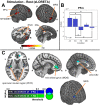The role of delta and theta oscillations during ego-motion in healthy adult volunteers
- PMID: 33534022
- PMCID: PMC8068649
- DOI: 10.1007/s00221-020-06030-3
The role of delta and theta oscillations during ego-motion in healthy adult volunteers
Abstract
The successful cortical processing of multisensory input typically requires the integration of data represented in different reference systems to perform many fundamental tasks, such as bipedal locomotion. Animal studies have provided insights into the integration processes performed by the neocortex and have identified region specific tuning curves for different reference frames during ego-motion. Yet, there remains almost no data on this topic in humans.In this study, an experiment originally performed in animal research with the aim to identify brain regions modulated by the position of the head and eyes relative to a translational ego-motion was adapted for humans. Subjects sitting on a motion platform were accelerated along a translational pathway with either eyes and head aligned or a 20° yaw-plane offset relative to the motion direction while EEG was recorded.Using a distributed source localization approach, it was found that activity in area PFm, a part of Brodmann area 40, was modulated by the congruency of translational motion direction, eye, and head position. In addition, an asymmetry between the hemispheres in the opercular-insular region was observed during the cortical processing of the vestibular input. A frequency specific analysis revealed that low-frequency oscillations in the delta- and theta-band are modulated by vestibular stimulation. Source-localization estimated that the observed low-frequency oscillations are generated by vestibular core-regions, such as the parieto-opercular region and frontal areas like the mid-orbital gyrus and the medial frontal gyrus.
Keywords: Alpha activity; Hemispheric asymmetry; Multisensory; Passive motion; Reference frames; Vestibular stimulation; Vestibular system.
Conflict of interest statement
The authors declare that they have no conflict of interest.
Figures




Similar articles
-
Spectral fingerprints of correct vestibular discrimination of the intensity of body accelerations.Neuroimage. 2020 Oct 1;219:117015. doi: 10.1016/j.neuroimage.2020.117015. Epub 2020 Jun 4. Neuroimage. 2020. PMID: 32505699
-
The cortical spatiotemporal correlate of otolith stimulation: Vestibular evoked potentials by body translations.Neuroimage. 2017 Jul 15;155:50-59. doi: 10.1016/j.neuroimage.2017.02.044. Epub 2017 Feb 22. Neuroimage. 2017. PMID: 28254458
-
Vestibular mapping of the naturalistic head-centered motion spectrum.J Vestib Res. 2023;33(5):299-312. doi: 10.3233/VES-210121. J Vestib Res. 2023. PMID: 37458057
-
The vestibular cortex. Its locations, functions, and disorders.Ann N Y Acad Sci. 1999 May 28;871:293-312. doi: 10.1111/j.1749-6632.1999.tb09193.x. Ann N Y Acad Sci. 1999. PMID: 10372080 Review.
-
Thalamocortical network: a core structure for integrative multimodal vestibular functions.Curr Opin Neurol. 2019 Feb;32(1):154-164. doi: 10.1097/WCO.0000000000000638. Curr Opin Neurol. 2019. PMID: 30461462 Review.
Cited by
-
Modification of cortical electrical activity in stroke survivors with abnormal subjective visual vertical: An eLORETA study.Heliyon. 2023 Nov 10;9(11):e22194. doi: 10.1016/j.heliyon.2023.e22194. eCollection 2023 Nov. Heliyon. 2023. PMID: 38027645 Free PMC article.
-
Different strategies in pointing tasks and their impact on clinical bedside tests of spatial orientation.J Neurol. 2022 Nov;269(11):5738-5745. doi: 10.1007/s00415-022-11015-z. Epub 2022 Mar 8. J Neurol. 2022. PMID: 35258851 Free PMC article.
-
EEG Techniques with Brain Activity Localization, Specifically LORETA, and Its Applicability in Monitoring Schizophrenia.J Clin Med. 2024 Aug 28;13(17):5108. doi: 10.3390/jcm13175108. J Clin Med. 2024. PMID: 39274319 Free PMC article. Review.
-
Cholinergic system correlates of postural control changes in Parkinson's disease freezers.Brain. 2023 Aug 1;146(8):3243-3257. doi: 10.1093/brain/awad134. Brain. 2023. PMID: 37086478 Free PMC article.
-
Vestibular-Evoked Cerebral Potentials.Front Neurol. 2021 Sep 21;12:674100. doi: 10.3389/fneur.2021.674100. eCollection 2021. Front Neurol. 2021. PMID: 34621231 Free PMC article. Review.
References
MeSH terms
Grants and funding
LinkOut - more resources
Full Text Sources
Other Literature Sources

